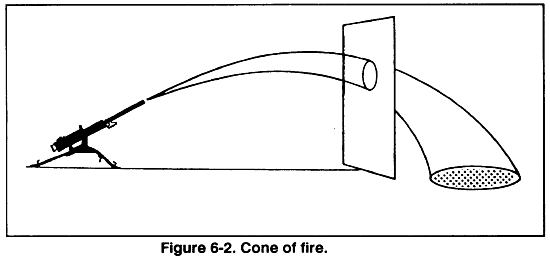Firing from the Defilade
There are some basic methods of firing that must be defined before discussing defilade fire. The first of these is line of sight. Line of sight is defined as the path from the gunner's eye to the target. This straight line makes corrections to the weapon system fairly simple.

http://www.dexadine.com/bexw.html
The cone of fire is the variation in the path a burst of rounds takes. This variation or cone is caused by the vibration of the weapon and its mount when fired in fully automatic, the variations in the ammunition and also the atmospheric conditions. The cone of fire differs from the type of mounting system used. The most stable mount is the M3 tripod.

http://atiam.train.army.mil/portal/atia/adlsc/view/public/296764-1/fm/23-65/ch6.htm#ch6
Many times during combat and training the gunner is able to see the target which makes adjustments to the weapon fairly simple. There are times however when a gunner must fire at a target when line of sight is impossible to obtain. This is referred to as firing from the defilade. Firing from the defilade has many advantages, the most vital of these advantages is that the enemy can not see the gunner, or the flash of the gun when fired.
Although when firing from the defilade position the gunner is out of sight, there must be a forward observer who can see the target so that they may give corrections to the gunner. Both the gunner and the forward observer must have a high knowledge of the weapons system and its capabilities as well as the accuracy of the traversing and elevating mechanism(which is explained at the link below).
Index
Traversing and Elevating Mechanism